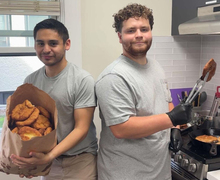SU takes steps toward Asian Studies minor
Andrea Wangsanata didn’t learn much about her heritage as a child. Her mother worked a lot, and she remained in the dark about her ancestors from China, Indonesia and the Philippines.
When she arrived at Syracuse University, Wangsanata found a misunderstanding of Asian-Americans and Asian culture.
‘There’s constant questioning of ‘you can’t be American because you’re Asian,” said Wangsanata, a sophomore public relations and political science major.
She joined a campaign to start an Asian and Asian American studies program at SU. Students have been pushing for this for more than 10 years, Wangsanata said. She’s now the student chair of a committee set up to make the program a reality.
The committee, set up last semester, has gained faculty support and created an official name for the proposal: Transnational Asian Studies Program.While the program isn’t official yet, two new Asia-focused courses are being piloted this semester.
One will be taught by Nancy Kang, a postdoctoral fellow in the College of Arts and Sciences. The course, ETS 182: Race and Literary Texts, will discuss Asian-American literature from all periods of U.S. history.
Sidney Greenblatt, a China specialist and self-proclaimed global nomad, will teach the other class. Greenblatt’s course, CAS 200: Transnational Asian Studies, will discuss Tibet and other political issues affecting the continent.
Susan Wadley, associate dean of curriculum in Arts and Sciences and one of the faculty members on the committee working for the program, secured special funding for the two new courses.
But both the students and the faculty on the committee said there’s more work to be done. The ultimate goal is to create a Transnational Asian Studies minor.
The committee hopes to officially propose the program next fall, Wadley said. If that happens, students would able to enroll in the program for the first time in Fall 2010, she said.
Greenblatt’s course doesn’t appear in the course catalog. It is listed on MySlice, but there is no course description, nor does Greenblatt’s name appear.
Kang’s class does appear in both the course catalog and on MySlice. But the course is still listed under the generic term, Race and Literary Texts. There is no mention in the course description that it will deal with Asian-American literature.
A minor consists of six courses or 18 credit hours. Four of those courses must be 300- level or above. Right now, the only Asian-American studies courses available are introductory level.
‘We have very minimal faculty expertise on the Asian-American side of (the program),’ Wadley said.
And the program will face an uphill battle since SU announced hiring freezes Thursday, she added.
‘The bottom line is the university just cut the budget by eight million dollars,’ she said. ‘And we need to have new faculty to make this happen. There are people who would be strong candidates who we could hire if we had the resources.’
The program also lacks a long-term chair.Prema Kurien, a sociology professor, is currently the interim chair. But Kurien said someone else should be hired to run the program permanently, because she can only teach one Asian-American studies program per semester.
The start of this movement for an Asian and Asian American studies program began April 11, 1997, said Carina Lui, a recent SU graduate who helped lead the campaign before handing it off to Wangsanata.
That night, several Asian-Americans and a white friend were refused service by a Denny’s on East Erie Boulevard in Syracuse. After being thrown out of the restaurant, they were attacked and badly beaten by a group of white males.
The Asian-Americans who were attacked were SU students.
‘It’s a hugely symbolic moment,’ Lui said of what is now known simply as ‘The Denny’s Incident.’
‘It involved Syracuse University and it involved the city.’
SU students held protests and rallies in the following months, Lui said. And since that night, Asian-Americans on campus have been pushing a program to call their own.
Lui said she encountered a great deal of stigma because of her race immediately when she arrived on the SU campus.
‘I was distraught that this university that promotes diversity has racially intolerant students,’ she said.
Lui grew up in New York City and took Asian American studies courses at her high school. When she came to SU, she couldn’t understand why there was no Asian American program here. She helped organize the beginnings of the movement for the Transnational Asian Studies Program.
She said she remembers struggling to get faculty support for the fledging program.’It was one excuse after another,’ she said. Kurien, the interim chair, first heard about the idea for an Asian and Asian American studies program in 2005. But the movement failed to pick up speed because at that point it was entirely student-led, she said.
Now with some of the faculty on board, those pushing for the program said everything hinges on whether or not SU will hire the additional professors to teach the 300-level courses.
‘I think we’re to the point now where we’re going to make it click,’ Wadley said. ‘We’re trying. We’re committed, and we’re committed in a time of declining resources.’
Published on July 7, 2009 at 12:00 pm





